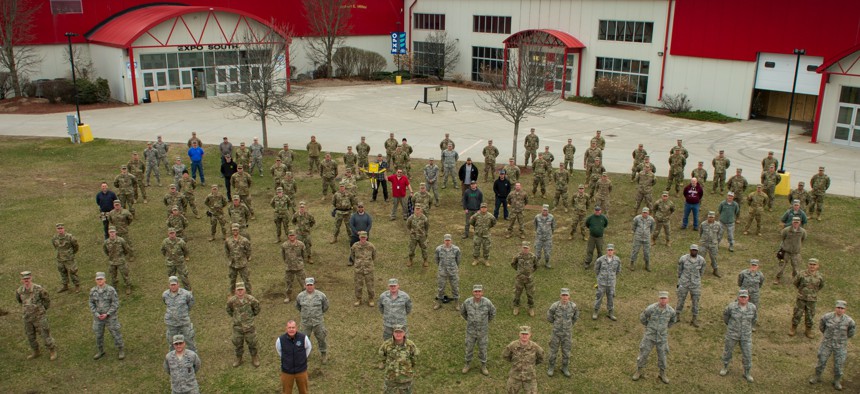
Airmen and soldiers of the Vermont National Guard, Vermont state employees, and contractors gather together for a group photo during the construction of a 400-bed alternate health facility in Essex Junction, Vt., April 5, 2020. Master Sgt. Michael Davis / Vermont National Guard
The Vermont National Guard’s Great Experiment
A few weeks ago, the state's Guardsmen got an impossible assignment. And then they pulled it off.
The call from his commanding officer came on a Sunday at the end of March, when Matthew Tatro was on his couch in front of the television. His life in small-town Vermont was already being reshaped by the coronavirus; for his usual job as a high-school music teacher, he’d been puzzling through how he could teach band remotely if and when the schools closed.
But now the governor was activating the National Guard, and Tatro, as a longtime guardsman, the bandmaster of the 40th Army Band, with 28 people under his leadership, had to mobilize himself and his fellow musicians to help get medical equipment to places in need around the state. Within days, the order came down from Brigadier General David Manfredi at the Vermont National Guard’s Joint Operations Command: Tatro and dozens of other guardsmen with day jobs, including teachers, master’s students, and at least one dental hygienist, would have to help build a 400-bed hospital to prepare for a possible wave of new patients. State and military planners wanted it ready to provide care within four days after construction started—when the state’s modeling suggested that Vermont, with its limited intensive-care capacity, might start running out of room for the very sick. It was like a Habitat for Humanity blitzkrieg for the coronavirus era.
Tatro enlisted in the Guard 27 years ago. In normal times, his unit plays at concerts, parades, and welcome ceremonies for visiting dignitaries, including the presidents of North Macedonia and Senegal. But the National Guard in each state is also a force that the governor can activate to help in a disaster—and in Vermont, the 40th Army Band provides much of the quick-reaction capability. In the past, this has involved filling sandbags for floods and chainsawing the occasional tree branch to remove it from the road after a hurricane. But this was something else altogether.
The story of how about 70 National Guardsmen managed to transform a convention center into an alternate health-care facility in mere days shows a state community coming together to get ahead of the pandemic at a time when the federal response is faltering. The military as a whole has struggled to adapt to the virus in its ranks—notably with the outbreak of cases on the aircraft carrier USS Theodore Roosevelt and inconsistent guidelines to protect members across the services.
Related: The Right Way to Activate the National Guard
Related: Leave the National Guard to the States, Says Top General
Related: US Military Can Do More to Help with Coronavirus, House Armed Services Chief Says
But around the country, teams like the Vermont guardsmen and members of the U.S. Army Corps of Engineers are practically defying physics to relieve stressed local hospitals in record time. The Vermont experiment stands out among similar projects across the country for its speed—and shows that at least one piece of the U.S. crisis response, specifically at the local level, is working.
Donald Trump’s freewheeling daily briefings are the icon of the federal response, and stimulus money and corporate bailouts are making their way around the country. But much of the real work of containing the pandemic is being done at the state level, with governors managing stay-at-home orders and teaming up to coordinate regional plans. It often falls to state actors to take care of their communities.
The pop-up hospitals aren’t the famous Chinese mega-constructions such as the one in Wuhan that 7,000 workers built from the ground up in about 10 days in February. Rather, members of the U.S. military are converting existing sites around the country—schools, convention centers, other vacant buildings—into spaces for patients displaced by the influx of coronavirus cases, or even for COVID-19 patients themselves. Vermont isn’t even at a point where its hospitals are overflowing. But state planners were observing the worrying trends elsewhere in the country, and they wanted to get ahead of what might be coming. “It was absolutely essential to look at that worst-case scenario and have capacity to meet it,” says Kerry Sleeper, the interim deputy secretary for Vermont’s Agency of Human Services, who manages surge capacity in the state. “We would have been negligent had we not done that.”
The new hospital started life as the Champlain Valley Exposition Center, three buildings amounting to 74,000 square feet, not too far from I-89 and accessible from a number of other hospitals off the highway. This had been a place for kids’ soccer and lacrosse games, antique expos and quilt shows and Tuesday bingo with a full snack bar. When Tatro went to visit the space with the lead civil engineer, Major Jason Villemaire, earlier this month, he had a hard time seeing the potential in all the emptiness. “I’m walking through these rooms … they’re like big empty spaces,” Tatro told me. “Major Villemaire is telling me what needs to happen, and I’m like, ‘It can’t happen. It can’t happen at all.’”
Villemaire put together the blueprints himself on Wednesday, April 1, working late into the night over pizza with a team of about seven other people. You can’t just put 400 beds in an expo center. Medical planners were asking Villemaire’s team to transform it into a space with eight 50-bed pods including an isolation ward, in case it had to take coronavirus patients. Each pod was to include a nursing station and supply closet as well as a sink, each bed to get its own electrical outlets and lamp nearby. Lieutenant Colonel Chris Gookin, the deputy state surgeon in the Vermont National Guard, recalls walking through the expo center before construction started and worrying about how everything would fit. “We’re having that moment of doubt where we’re like, ‘It’s not going to be big enough,’” he told me. He was imagining filling it up with two-by-fours, nursing units, sinks, beds, emergency exits, and corridors.
Villemaire wasn’t as worried. As a full-time engineer at the Burlington Air National Guard Base, he manages the infrastructure for a facility that hosts 15 F-35 fighter jets. He’d enlisted as an air mechanic in the late 1980s, and had experience building things quickly with few resources on deployments. But the scale of this project was altogether new to him..
“I’ve never done anything of this scope all at the same time,” he told me. And normally, for a project this big, it would take more than a week just to get all the personnel in place. “We were able to do it in a matter of hours.”
The advantage of the expo center was that it already had its own power, plumbing, heating, and ventilation. Still, Villamaire’s team needed to put up dozens of walls to separate each pod from the others and to divide each into two sections, for men and women; run new electrical wiring within the walls to get power next to each bed; and run plumbing to the sinks in the nurse’s stations. This would mean erecting close to a mile’s worth of walls eight feet high, a similar length of new electrical wiring to connect to 432 different power outlets, and about 1,200 feet of plumbing.
Villemaire showed up with a few dozen people on Thursday, April 2; they knew they needed walls and where they should go, so they began hammering plywood to two-by-fours and putting them up. But it was clear by the end of the day that they’d need a lot more people to get the project done in time.
Reinforcements came on Friday, when Tatro showed up with his team. By now, the entire construction crew had grown to about 55 members. Emily Eckel, who plays the bassoon in the Guard and is a master’s student in music therapy, was one of few with a carpentry background—from a work-study job in college building sets for Godspell and A Midsummer Night’s Dream. She felt, she told me, “like the stars have aligned … I knew enough to put up walls, and I could use power tools.”
The construction settled into an assembly-line rhythm over 14-hour days stretching into the weekend, by which point the team had grown close to 70 people. People would nail together walls and stack them up, then move them into position; electrical came next, alongside plumbing. One big room, then another, then another.
By Sunday, when Tatro walked back through the event space, the empty halls had been transformed, and workers were covering the new walls in plastic sheeting that could be easily cleaned and sterilized. The facility was ready to receive patients.
But none actually came for another several days. Ordered to sprint to be ready on Sunday, April 5, the guardsmen didn’t see any patients until the following Friday. By that point, the Guard’s medical personnel were training the others to serve as orderlies in the new hospital, and band members were walking around trying to encourage the staff. “I’ve already had one guy with a guitar walk around and play some music for the medics,” Tatro said.
And then, last Friday, the center got its first patient, sent straight to the isolation ward. They were infected with the coronavirus.




